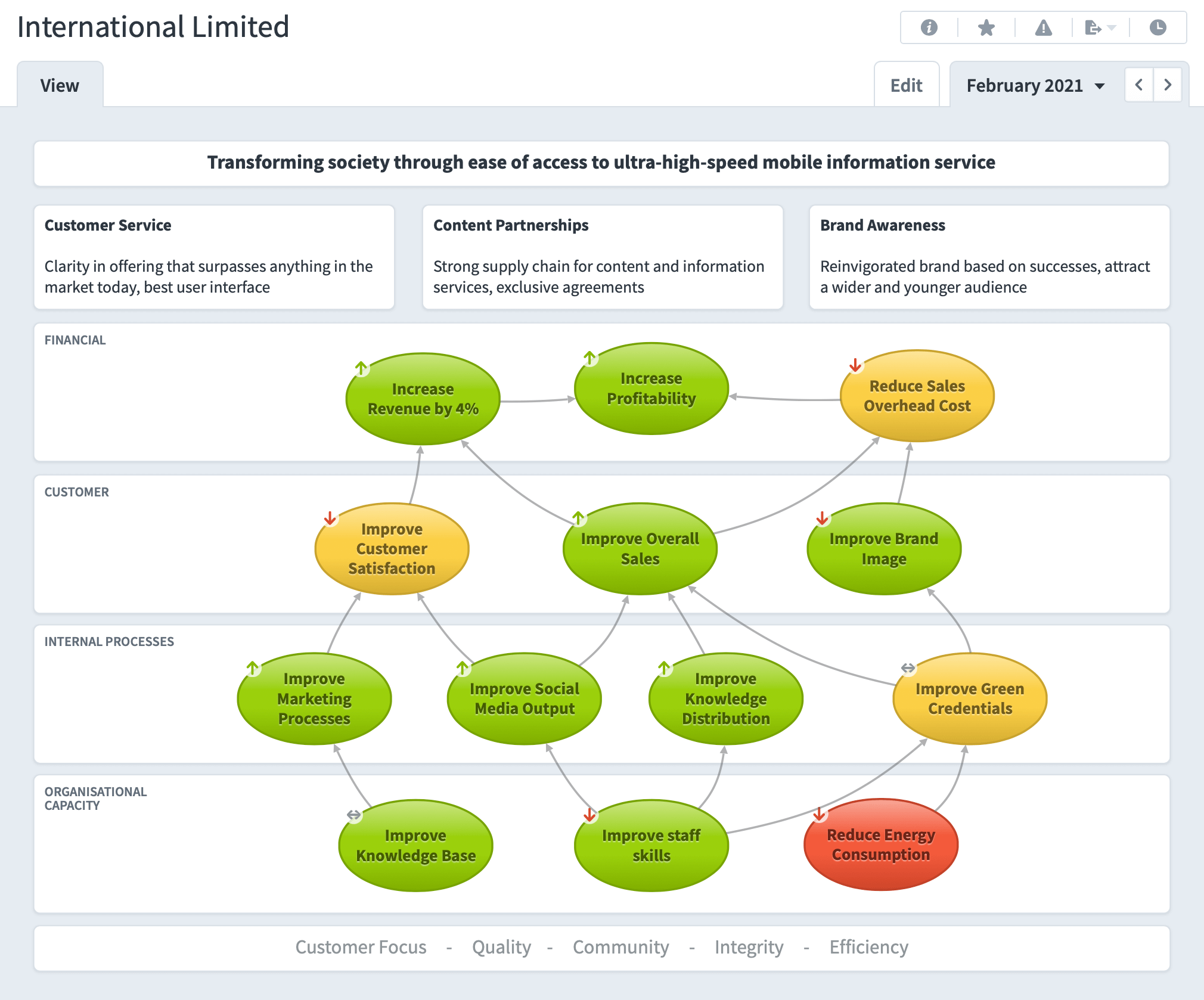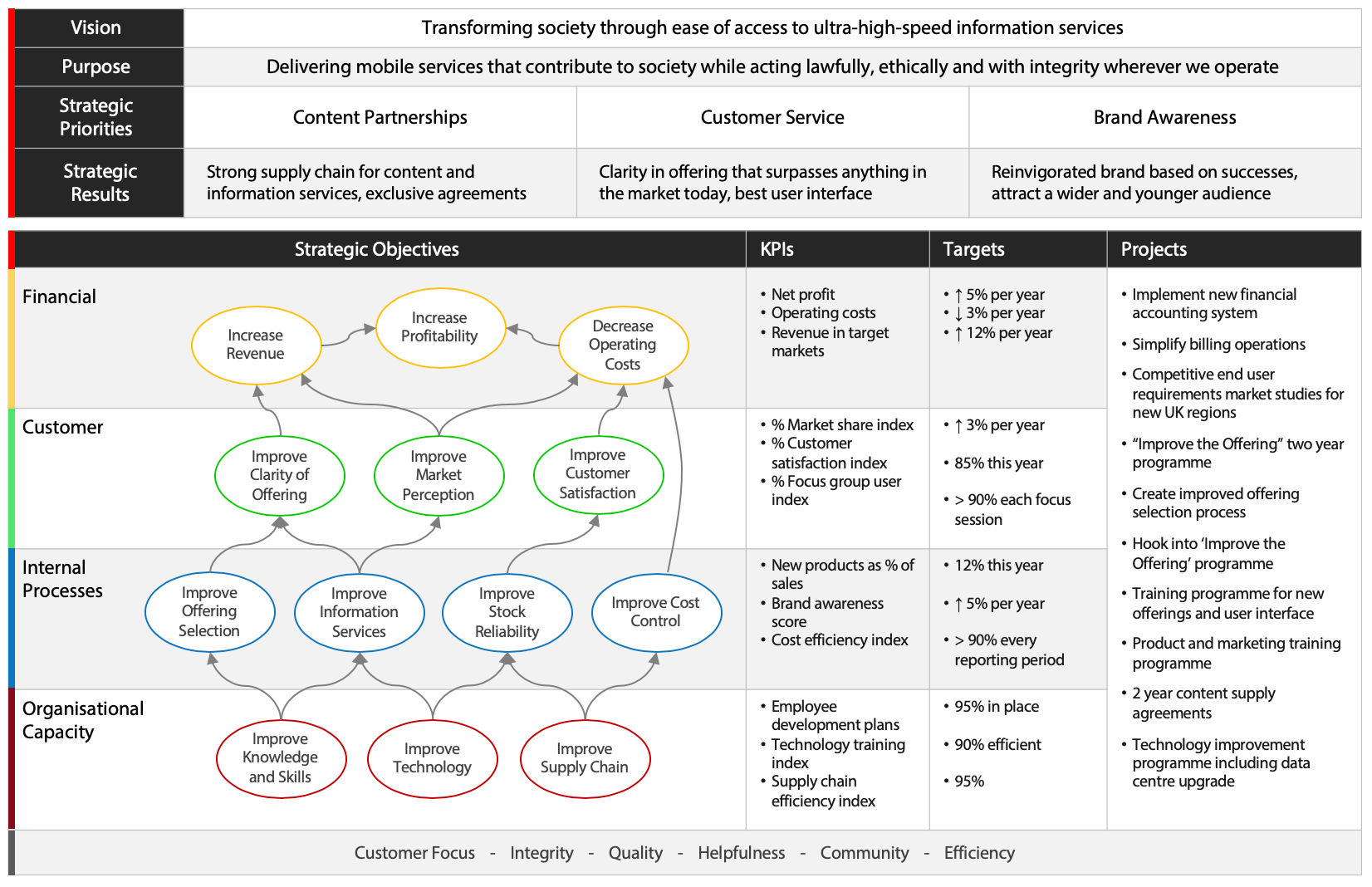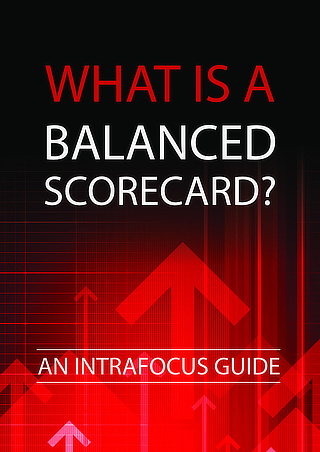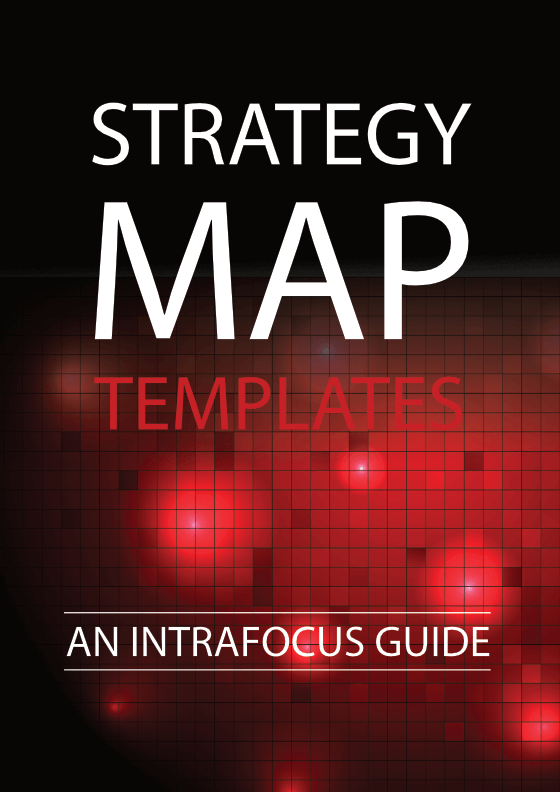What is a Balanced Scorecard?
The Balanced Scorecard (BSC) is a strategic management tool that helps organisations translate vision into action. It connects overarching goals with daily operations by using clear objectives, performance measures, and strategic initiatives. Unlike traditional reporting methods, the BSC looks beyond financial results, monitoring performance across four key perspectives: Financial, Customer, Internal Processes, and Organisational Capacity. The outcome? A comprehensive view of progress that enables businesses to stay focused, aligned, and prepared to enhance their performance.
The Balanced Scorecard was introduced by Dr. Robert Kaplan and Dr. David Norton in a 1992 Harvard Business Review article, which challenged the traditional over-reliance on financial metrics for measuring business success. Their groundbreaking insight was that financial data alone couldn’t reflect the full picture of organisational health or future performance. What was needed was a broader set of measures—ones that could capture intangible assets, such as customer satisfaction, innovation, and employee development.
The concept gained rapid traction, and by 1996, Kaplan and Norton had expanded it into a full methodology in their book The Balanced Scorecard: Translating Strategy into Action. Interestingly, the roots of the approach can be traced back to Art Schneiderman, who had developed a similar framework at Analogue Devices. Kaplan and Norton built upon this foundation, shaping a system that has since been adopted by thousands of organisations worldwide—from government agencies to multinational corporations.
Over the years, the Balanced Scorecard has evolved from a simple reporting framework into a comprehensive system for strategic planning, performance management, and organisational alignment. Today, it is recognised not just as a measurement tool, but as a vehicle for executing strategy across the enterprise.
The Four Perspectives
At the heart of the Balanced Scorecard are four core perspectives. These perspectives serve as lenses through which an organisation can view and manage performance, ensuring that strategy is implemented in a holistic and sustainable way.
Financial Perspective
Key Question: How do we look to our shareholders or stakeholders?
The financial perspective focuses on traditional metrics, including revenue growth, profitability, cost efficiency, and return on investment. These are the end results of your strategy. They tell you whether your efforts are ultimately producing value.
However, financial outcomes are lagging indicators. They measure what has already happened. If revenue has declined, it’s too late to fix the problem in that quarter. That’s why the BSC connects financial performance to other leading indicators, found in the perspectives below.
Examples of Financial KPIs:
- Operating profit
- Return on capital employed (ROCE)
- Cost-to-income ratio
Customer Perspective
Key Question: How do our customers perceive us?
This perspective shifts the focus outward, looking at what matters most to customers. It includes objectives and KPIs related to customer satisfaction, loyalty, market share, and brand reputation.
Understanding the customer’s viewpoint is critical for long-term success. It’s not just about delivering products—it’s about meeting expectations and building relationships. An organisation that fails to understand its customers is unlikely to grow, no matter how efficient its internal processes are.
Examples of Customer KPIs:
- Net Promoter Score (NPS)
- Customer retention rate
- Complaint resolution time
Internal Process Perspective
Key Question: What must we excel at internally to satisfy our customers and achieve our financial goals?
This area focuses on the business processes that drive customer value and efficiency. Whether it’s product development, supply chain management, or customer service workflows, internal processes must be optimised to deliver results.
Improvements here often lead to faster delivery, higher quality, lower costs, and better customer experiences. It’s also the space where innovation often begins—turning operational insight into strategic advantage.
Examples of Internal Process KPIs:
- Time to market
- First-pass yield
- Order fulfilment accuracy
Organisational Capacity
(formerly Learning & Growth)
Key Question: How can we improve and sustain our ability to change and create value?
This foundational layer supports everything above it. Organisational capacity includes employee skills, company culture, leadership capability, and IT systems. It answers the question of whether your organisation has the tools and talent to innovate and adapt.
This is also the area where most long-term investment takes place. Without strong organisational capacity, internal processes break down, customers become dissatisfied, and financial performance suffers.
Examples of Organisational Capacity KPIs:
- Employee engagement index
- IT system uptime
- Training hours per employee
Together, these four perspectives allow organisations to connect intangible drivers of success (like culture and innovation) to tangible outcomes (like profit and growth). That’s the real power of a “balanced” scorecard.
Strategy Maps
Connecting the Dots
A Strategy Map is a visual tool that illustrates how objectives within each of the four perspectives are interconnected. It provides a clear, one-page diagram of your strategy, making it easier to communicate, align, and act.
Think of it as the Balanced Scorecard brought to life. Each strategic objective is plotted in one of the four perspectives, with arrows showing how improvements in one area lead to results in another. For example:
- Improved training (Organisational Capacity) leads to
- More efficient service delivery (Internal Processes), which leads to
- Higher customer satisfaction (Customer), resulting in
- Increased revenue (Financial)
This cause-and-effect logic is what transforms the BSC from a measurement tool into a strategic roadmap.
In software tools like Spider Impact, strategy maps become interactive. You can click on an objective to drill down into its KPIs, view historical trends, and link to related initiatives. But even on paper, the strategy map is an incredibly effective communication device.

Strategic Objectives vs. Projects:
What’s the Difference?
One of the most common mistakes organisations make when building a Balanced Scorecard is confusing strategic objectives with projects. The two are related—but not interchangeable.
A strategic objective is a continuous improvement goal. It’s a direction of travel. It doesn’t end. A project, on the other hand, is a temporary initiative. It has a start date, an end date, and a specific outcome.
Let’s look at an example:
- Project: “Implement a new CRM system.”
- Strategic Objective: “Improve customer service through better technology.”
The project might support the objective, but it is not the objective itself. Why does this matter? Because you can complete the project and still fail to achieve the strategic outcome. A shiny new CRM system means nothing if staff don’t use it or if it doesn’t solve the real problems customers face.
By focusing on strategic objectives first—and only then identifying the projects needed to support them—you avoid wasting time and money on disconnected initiatives. It also makes your strategy more flexible: if one project fails or stalls, you can explore another path to achieving the same objective.
This approach also improves performance measurement. You can track whether your objective is being achieved over time (e.g. improved customer satisfaction scores), not just whether a project milestone was completed.
🧠 Tip: When defining your strategy, ask “What do we want to improve?” before asking “What should we do?”
KPIs & Performance Measures
Tracking What Matters
Once your strategic objectives are clear, you need a way to monitor progress. That’s where Key Performance Indicators (KPIs) come in. KPIs are carefully selected metrics that reflect whether your organisation is moving toward its goals. They’re not just about measurement—they’re about insight.
But beware: not all measures are KPIs. Many organisations fall into the trap of measuring everything and calling it strategic. The truth is, KPIs are the few vital signs, not the entire medical chart.
Think of them like a dashboard in your car:
- Lagging indicators show you what happened (e.g. quarterly revenue)
- Leading indicators help you predict what’s coming (e.g. sales pipeline volume)
Both are essential. Lagging KPIs confirm if you’ve succeeded. Leading KPIs help you influence future outcomes.
Here’s an example:
- Objective: Improve customer satisfaction
- Leading KPI: Percentage of service issues resolved within 24 hours
- Lagging KPI: Customer satisfaction survey score
Leading indicators are harder to define but more powerful. They are the only ones you can influence in real-time. By contrast, lagging indicators tell you whether you’ve hit the target—but not how to adjust if you’re falling short.
Another trap? Confusing operational measures with KPIs. For example, tracking how many phone calls a service agent takes may be useful, but it’s not “key” unless it links to a strategic outcome like faster response time or better customer experience.
📌 Golden rule: A KPI must be linked to a strategic objective. If you can’t draw a direct line between the measure and a goal, it probably doesn’t belong on the scorecard.
Balanced Scorecard Software
Do You Need It?
In the early stages, many organisations build their scorecards using Excel, PowerPoint, or Word. These tools are familiar, flexible, and free. But they have limits—especially as your strategy matures and the number of users grows.
Here’s where Balanced Scorecard software becomes essential. Tools like Spider Impact provide features that Excel can’t:
- Strategy maps that update automatically as data changes
- Cascading scorecards across departments and teams
- Drill-down dashboards to explore performance trends
- Automated KPI scoring and alerts
- Initiative management with task tracking and ownership
- Real-time reporting for leadership briefings
Software doesn’t replace strategy—it enables it. It connects everyone to the same version of the truth, reduces reporting workload, and ensures your scorecard becomes a living, breathing part of day-to-day work.
When selecting a tool, look for:
- Ease of use for non-technical users
- Web-based access for remote and hybrid teams
- Strong visualisation options (e.g. traffic lights, gauges, graphs)
- Integration with your data sources
💡 Want to see it in action? Explore our Balanced Scorecard Software powered by Spider Impact.
Who Uses the Balanced Scorecard?
The Balanced Scorecard is used across industries, sectors, and organisational sizes. What started in large corporations has been adapted for use by small to mid-sized businesses, government bodies, and nonprofits.
Some well-known users include:
- Philips Electronics
- UPS
- Volkswagen
- The FBI
- Thomson Reuters
It works because the principles are universal: align goals, measure what matters, and act on what you learn.
That said, the BSC is best suited to established organisations with a clear purpose and structure. It’s not ideal for startups still experimenting with business models. But for any organisation aiming to improve performance and drive strategy, the BSC is an invaluable tool.
Key Benefits
After three decades of use around the world, the Balanced Scorecard has proven itself to be more than just a measurement framework. It’s a full strategic management system that offers several long-term benefits:
- Organisational Alignment
Everyone understands what matters and how their work contributes to strategic success. Teams stop working in silos.
- Clarity and Focus
Instead of chasing dozens of disconnected goals, the BSC forces prioritisation. You define what success looks like—then focus on getting there.
- Smarter Planning
Strategy maps clarify cause and effect. KPIs make performance visible. Projects are tied directly to strategic objectives.
- Improved Reporting
No more endless spreadsheets or reactive reporting. The scorecard highlights what’s working, what’s not, and where to focus next.
📄 Don’t forget: You can download our guide on “What is a Balanced Scorecard” and get our free strategy map templates at the top of this page to start building your own.
Frequently Asked Questions
What are the four perspectives of the Balanced Scorecard?
The four perspectives are Financial, Customer, Internal Processes, and Organisational Capacity (formerly Learning & Growth). Each offers a unique view of performance, helping organisations link day-to-day activities to long-term goals.
Why is the Balanced Scorecard important?
It provides a structured, balanced way to manage strategy. By connecting vision, objectives, KPIs, and initiatives, it helps organisations stay focused and aligned—improving performance across the board.
What’s the difference between KPIs and operational metrics?
KPIs are tied to strategic objectives and are usually few in number. Operational metrics may track activity, but they don’t always indicate strategic progress. The best KPIs simplify complexity and support decision-making.
Can the Balanced Scorecard be used by small businesses?
Yes. While originally developed for large enterprises, the BSC scales well. Small and mid-sized organisations use simplified scorecards to align teams and improve decision-making. The key is to focus on just a few priorities.
Is Balanced Scorecard software necessary?
You can start without it, but as your scorecard grows, software becomes essential. It enables real-time reporting, automated tracking, and alignment across departments—making strategy easier to manage and sustain.
It is not just a tool.
The Balanced Scorecard isn’t just a tool—it’s a mindset. It challenges organisations to think strategically, act deliberately, and measure intelligently. Whether you’re a business leader, a public sector strategist, or a team manager, the BSC gives you the structure and focus to deliver results.
Want help getting started? Explore our free resources, attend a strategy workshop, or try our software and see how the Balanced Scorecard can work for you.
Watch the Video
Download a copy of the final drawing.
Read our guide: What is a Balanced Scorecard?
Download our Strategy Map Templates
The Integrated Balanced Scorecard
The example above is an example of an Integrated Balanced Scorecard. It includes all the elements of a strategy from Vision through to Initiatives. For more information on how to create an integrated strategy go to our Strategy Workshop pages.




